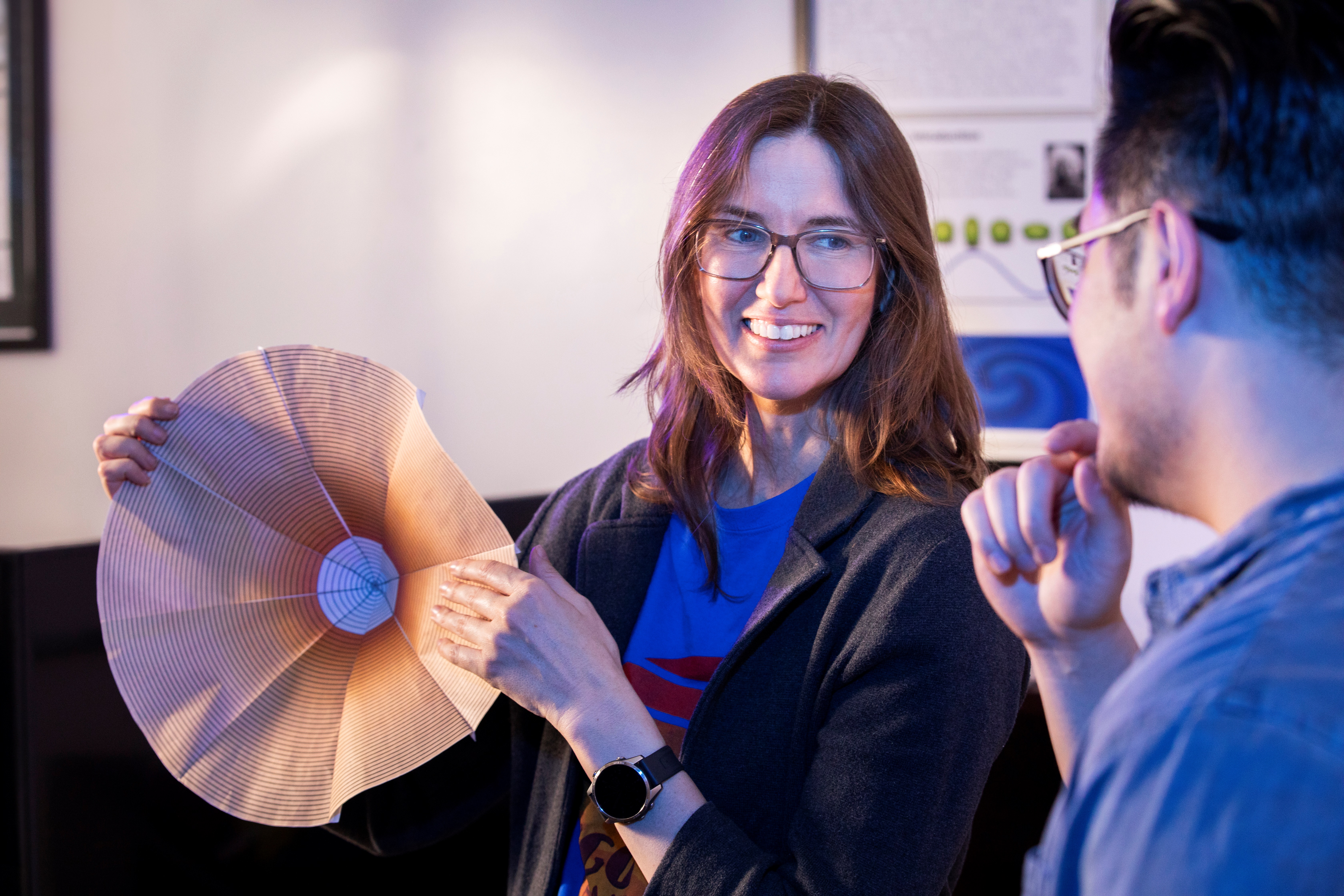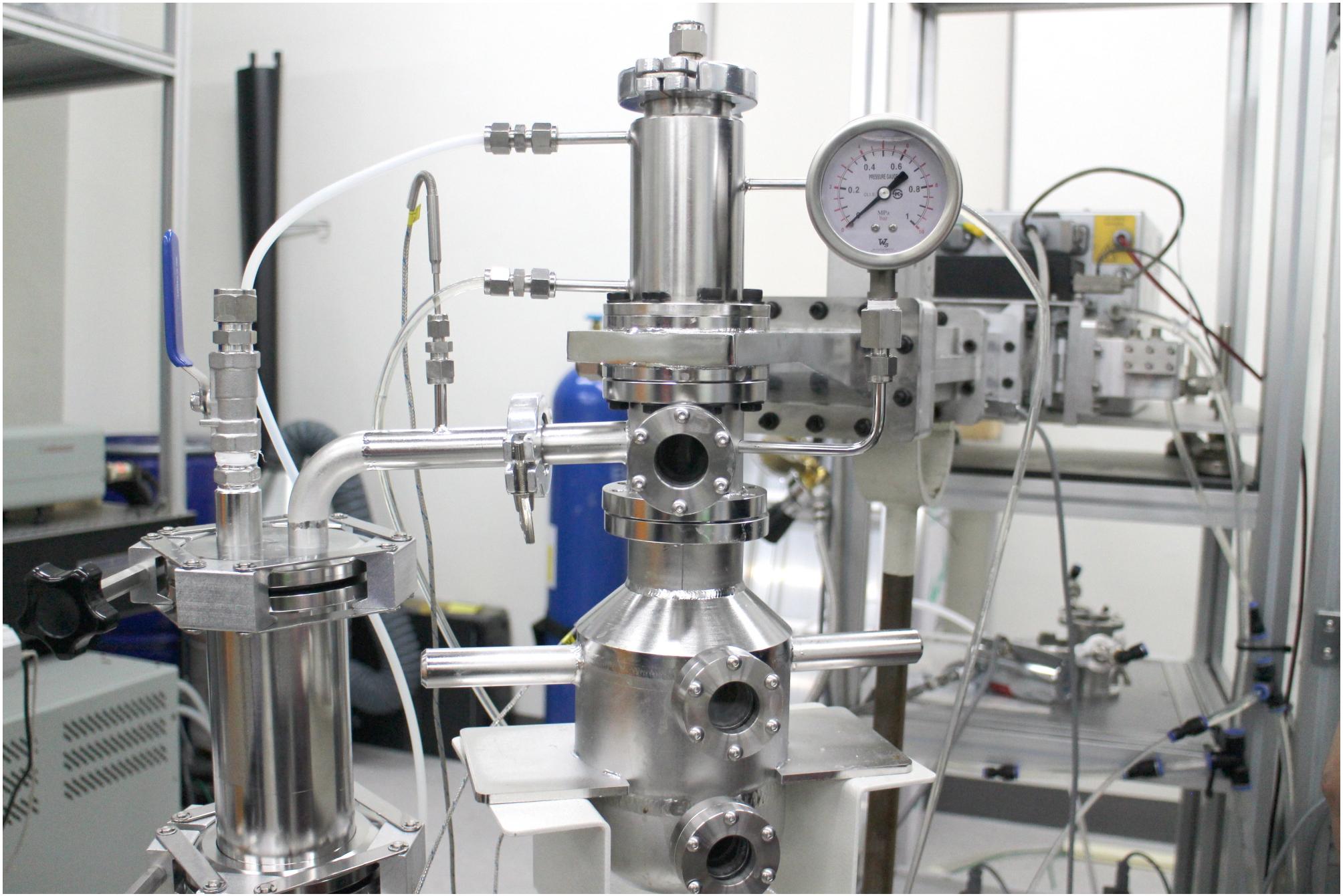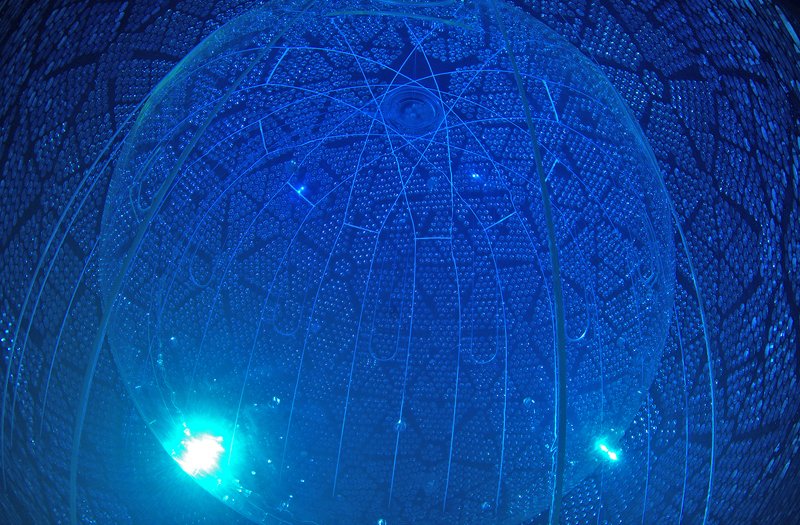Scientists from Washington University in St. Louis have launched a balloon-borne telescope to unlock the secrets of astrophysical black holes and neutron stars, some of the most extreme objects in the universe. The device known as XL-Calibur was launched from the Swedish Space Corporation’s Esrange Space Center, situated north of the Arctic Circle near Kiruna, Sweden, July 9.
Tag: Physics
Three Argonne postdocs invited to prestigious meeting of Nobel laureates
Three Argonne postdoc scientists have been invited to the prestigious Nobel Laureate Meetings in Lindau, Germany, where they will meet with past Nobel Prize winners in their fields.
New Radiative Transfer Modeling Framework Enhances Deep Learning for Plant Phenotyping
A research team has developed a radiative transfer modeling framework using Helios 3D plant modeling software to simulate RGB, multi-/hyperspectral, thermal, and depth camera images with fully resolved reference labels.
Celebrating the legacy of Maria Goeppert Mayer
Maria Goeppert Mayer left an indelible mark on science through her groundbreaking contributions to nuclear physics. A Nuclear Structure Conference at Argonne will highlight her contributions to physics theory.
Processes, models and the influencing factors for enhanced boiling heat transfer in porous structures
Abstract Due to the increasing volume of electric vehicles in automotive markets and the limited lifetime of onboard lithium-ion batteries, the large-scale retirement of batteries is imminent. The battery packs retired from electric vehicles still own 70%–80% of the initial capacity, thus having…
Prominent Physicist, Prof. Enge Wang, Visits HKIAS at City University of Hong Kong
The Hong Kong Institute for Advanced Study (HKIAS) at City University of Hong Kong (CityUHK) welcomed Professor Enge Wang from June 3 to June 7, 2024. Prof. Wang, a Senior Fellow of HKIAS and University Chair Professor of Physics at Peking University, is a distinguished member of the Chinese Academy of Sciences.
Apple versus doughnut: How the shape of a tokamak impacts the limits of the edge of the plasma
PPPL scientists have developed a new theoretical model about the edge of a plasma, which can become unstable and potentially damage a fusion reactor. The model refines ideas about a critical obstacle on the path to harnessing clean energy from this fourth state of matter.
Comprehensive Detection of Light: Dispersion-assisted Photodetector Deciphering High-dimensional Light
The intricate nature of light, characterized by its intensity, polarization, and spectrum composition, holds profound importance across a range of scientific and technological disciplines. From enhancing optical communications to enabling precise chemical and biological characterization, a comprehensive understanding of light’s properties is indispensable.
Innovative Material for Sustainable Building
Researchers at the Karlsruhe Institute of Technology (KIT) introduce a polymer-based material with unique properties in the latest issue of the journal Nature Communications. This material allows sunlight to enter, maintains a more comfortable indoor climate without additional energy, and cleans itself like a lotus leaf. The new development could replace glass components in walls and roofs in the future
Promethium bound: Rare earth element’s secrets exposed
Scientists have uncovered the properties of a rare earth element that was first discovered 80 years ago at the very same laboratory, opening a new pathway for the exploration of elements critical in modern technology, from medicine to space travel.
Comparison of four methods on drying efficiency and physicochemical properties of chicken meat
In this study, four drying methods including hot air drying (HAD), catalytic infrared drying (CIRD), electric infrared drying (EIRD) and electric oven drying (EOD) were used to prepare dried chicken breast. The study systematically compared the drying efficiencies of different methods and their effects on physico-chemical properties, pet food applications, energy consumption, and cost.
DOE’s Office of Science Graduate Student Research Program Selects 86 Outstanding U.S. Graduate Students
The Department of Energy’s (DOE’s) Office of Science has selected 86 graduate students representing 31 states and Puerto Rico for the Office of Science Graduate Student Research (SCGSR) program’s 2023 Solicitation 2 cycle.
João Barata Awarded CERN Fellowship
João Barata, a physicist in the Nuclear Theory Group at the U.S. Department of Energy’s (DOE) Brookhaven National Laboratory, has received a fellowship at CERN, the European Organization for Nuclear Research. In October 2024, Barata will begin the three-year-long appointment in CERN’s Department of Theoretical Physics.
New Technique Lets Scientists Create Resistance-Free Electron Channels
Researchers have taken the first atomic-resolution images and demonstrated electrical control of a chiral interface state – an exotic quantum phenomenon that could help researchers advance quantum computing and energy-efficient electronics.

CSUF Scientists Contribute to Mysterious Gravitational-Wave Signal From Neutron Star-Black Hole Cosmic Collision
Cal State Fullerton physicists are on the forefront of a new discovery of gravitational waves from two compact cosmic objects not seen by scientists before.
MRL MVPs: Chris Anderson
Chris Anderson is the newest addition to the Materials Research Laboratory (MRL) faculty, and he is ready to make a quantum leap into the world of materials science.
FAU Experts Available to Discuss Upcoming Solar Eclipse
Experts from Florida Atlantic University’s Charles E. Schmidt College of Science are available to discuss various aspects related to the upcoming solar eclipse.
Four PPPL researchers featured in the Physics of Plasmas
PPPL’s important work seeding the field of plasma physics was evident from the list of first authors in Physics of Plasmas 2023 Early Career Collection, which included four people from the Lab: Ben Isreali, Stephen Majeski, Ian Ochs and Willca Villafana.
Four PPPL researchers featured in the Physics of Plasmas
PPPL’s important work seeding the field of plasma physics was evident from the list of first authors in Physics of Plasmas 2023 Early Career Collection, which included four people from the Lab: Ben Isreali, Stephen Majeski, Ian Ochs and Willca Villafana.
Professor Enge Wang Engages in Academic Exchanges at CityUHK
Our Senior Fellow Professor Enge Wang recently visited HKIAS between 4 March to 8 March 2024 and participated in academic exchanges at City University of Hong Kong (CityUHK).
Finding new physics in debris from colliding neutron stars
Neutron star mergers are a treasure trove for new physics signals, with implications for determining the true nature of dark matter, according to research from physicist Bhupal Dev at Washington University in St. Louis.
Shaping the Future: A New Technique for Sorting Micro-Particles Unveiled
Thanks to the rapid progress in tiny tech, we’ve been mainly using microfluidics to sort tiny particles by size. But now, there’s a new way to sort them by shape, which could be a big deal for medical tests and chemistry. This study shows off a new method using sound waves to separate oddly shaped particles from round ones, without needing any labels.

Plasma Technology for More Effective Lithium Extraction
Korea Institute of Fusion Energy(KFE) announced revealed that their researchers have successfully increased the lithium extraction rate by three times compared to pre-existing methods by applying CO2 microwave plasma technology.
First-ever atomic freeze-frame of liquid water
A multi-institutional team reports the first look at electrons moving in real time in liquid water. Their findings could affect studies of radiation-induced processes, such as those in space travel, cancer treatments, nuclear reactors and legacy waste.
New nuclei can help shape our understanding of fundamental science on Earth and in the cosmos
In creating five new isotopes, an international research team working at the Facility for Rare Isotope Beams, or FRIB, at Michigan State University has brought the stars closer to Earth.
Altermagnetism proves its place on the magnetic family tree
Experiments at the Swiss Light Source SLS prove the existence of a new type of magnetism, with broad implications for technology and research.
Results from South Pole Telescope’s new camera emerge
A newly published study led by researchers from Argonne National Laboratory details early measurements from a new camera at the South Pole Telescope.

SNO+ Reveals the Power of Neutrinos
It may be snowy outside, but the water in the SNO+ experiment isn’t for building snowmen. SNO+ is short for the Sudbury Neutrino Observation+, a neutrino experiment 2 kilometers underground in a mine in Ontario, Canada.
UC Irvine scientists make breakthrough in quantum materials research
Irvine, Calif., Jan. 31, 2024 — Researchers at the University of California, Irvine and Los Alamos National Laboratory, publishing in the latest issue of Nature Communications, describe the discovery of a new method that transforms everyday materials like glass into materials scientists can use to make quantum computers.
UC Irvine-led team unravels mysteries of planet formation, evolution in distant solar system
Irvine, Calif., Jan. 29, 2024 – A recently discovered solar system with six confirmed exoplanets and a possible seventh is boosting astronomers’ knowledge of planet formation and evolution.
Argonne National Laboratory set to play pivotal role in realizing U.S. goals for nuclear science research
The Nuclear Science Advisory Committee recently unveiled its 2023 Long Range Plan for nuclear science. Argonne National Laboratory, with its world-class nuclear physics facilities and expertise, is poised to play a pivotal role in realizing the plan.
Argonne event helps Hispanic students explore their dreams of STEM careers
Forty eighth grade students — many originally from Mexico, Colombia, Venezuela and elsewhere — learned firsthand how scientists of Hispanic/Latino heritage contribute to science during the 18th annual Hispanic/Latino Education Outreach Day at Argonne.
How Could a Piece of the Moon Become a Near-Earth Asteroid? Researchers Have an Answer
A team of astronomers has found a new clue that a recently discovered near-Earth asteroid, Kamo`oalewa, might be a chunk of the moon.
Argonne and industry collaborate to shape nuclear’s future
Seven private companies demonstrate the impact of partnering with the U.S. Department of Energy and its national laboratories to advance nuclear reactor designs, fight climate change and provide secure energy to the nation.
Manipulating nonlinear exciton polaritons in an atomically-thin semiconductor with artificial potential landscapes
Nonlinear exciton polaritons in TMDs microcavities provide a versatile platform for exploring interacting many-body phenomena. To achieve an appropriate combination of strong nonlinearity with the thermal stability of the polaritons, scientists from Tsinghua University, Wuhan University and Beijing Academy of Quantum Information Sciences jointly developed the artificial mesa cavities to manipulate the nonlinear interaction and the macroscopic coherence of polaritons at ambient conditions. This work will stimulate more developments in realistic polaritonic applications based on the TMDs microcavities.
Physicists demonstrate powerful physics phenomenon
In a new breakthrough, researchers have used a novel technique to confirm a previously undetected physics phenomenon that could be used to improve data storage in the next generation of computer devices.
“A new lens” into the Universe’s most energetic particles
Showers in bathrooms bring us comfort; showers from space bring astrophysicists joy. Osaka Metropolitan University scientists have observed, with their novel method, cosmic-ray extensive air showers with unprecedented precision, opening the door to new insights into the Universe’s most energetic particles.
New ‘Long Range Plan for Nuclear Science’ recommends FRIB enhancements to forward the field
The Facility for Rare Isotope Beams, or FRIB, figures largely in the Nuclear Science Advisory Committee’s, or NSAC’s, newly released “A New Era of Discovery: The 2023 Long Range Plan for Nuclear Science.” The new plan, released on Oct. 4, provides a roadmap for advancing the nation’s nuclear science research programs over the next decade. It is the eighth long range plan published by NSAC since 1979.
Could a new law of physics support the idea we’re living in a computer simulation?
A University of Portsmouth physicist has explored whether a new law of physics could support the much-debated theory that we are simply characters in an advanced virtual world.

$10 million award from the Department of Defense will fund pioneering Sensing and Cyber Center of Excellence
The Virginia Tech College of Engineering has received a $10 million, five-year Department of Defense award to fund groundbreaking research with potential military and commercial implications.
AIP Congratulates 2023 Nobel Prize Winners in Physics
To help journalists and the public understand the context of this year’s Nobel Prize, AIP is compiling a resources page featuring relevant scientific papers and articles, quotes from experts, photos, multimedia, and other resources.
FAU Engineering Study Employs Deep Learning to Explain Extreme Events
At the core of uncovering extreme events such as floods is the physics of fluids – specifically turbulent flows.
Expert available to comment on CERN’s Antimatter experiment
Professor Glenn Patrick is a visiting professor in the School of Mathematics and Physics at the University of Portsmouth. Professor Patrick was a recent member of the LHCb collaboration at CERN studying the subtle differences between matter and antimatter. He…
Solar cell material can assist self-driving cars in the dark
Material used in organic solar cells can also be used as light sensors in electronics. This is shown by researchers at Linköping University, Sweden, who have developed a type of sensor able to detect circularly polarised red light.
Argonne to recycle magnets from Advanced Photon Source in new physics experiment at Brookhaven
Argonne is recycling 700 magnets as its Advanced Photon Source undergoes an upgrade, and the old magnets will be used for the Electron-Ion Collider.
Does antimatter fall up or down? Physicists observe the first gravitational free-fall of antimatter
The physics behind antimatter is one of the world’s greatest mysteries. Looking as far back as The Big Bang, physics has predicted that when we create matter, we also create antimatter.
Perimeter and Haiqu partnership forges new model for quantum computing research
The Perimeter Institute and quantum software startup Haiqu have established a new partnership to more closely connect fundamental research and technological innovation.
What is quantum squeezing?
Scientists exploit a property of quantum physics to make ultraprecise sensors and measurements.
A new way to create germ-killing light
While it has long been known that ultraviolet (UV) light can help kill disease-causing pathogens, the COVID 19 pandemic has put a spotlight on how these technologies can rid environments of germs.
Groundbreaking research shows that the limits of nuclear stability change in stellar environments where temperatures reach billions of degrees Celsius
New research is challenging the scientific status quo on the limits of the nuclear chart in hot stellar environments where temperatures reach billions of degrees Celsius.